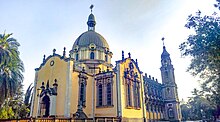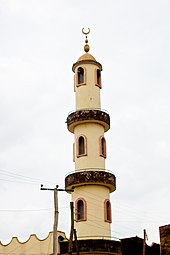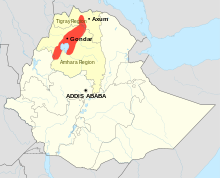Religion in Ethiopia

Religion in Ethiopia consists of a number of faiths. Among these mainly
According to the national census conducted in 2007, over 32 million people or 43.5% were reported to be
The Kingdom of Aksum in present-day Ethiopia and Eritrea was one of the first Christian countries in the world, having officially adopted Christianity as the state religion in the 4th century.[3] The Ethiopian Empire was the only region of Africa to survive the expansion of Islam as a Christian state.[4]
History
This section needs expansion. You can help by adding to it. (November 2023) |
Geography
In general, most of the
Abrahamic religions


Ethiopia has close historical ties to all three of the world's major
Christianity

Ethiopia is one of the oldest Christian states in the world. The

In 2016, the government stated that 67% of the country is Christian (44% of the population belonging to the Ethiopian Orthodox Church).[6]
According to the government's 1994 census (which the
Orthodox Ethiopian Christians are predominant in the

The
The name "Ethiopia" (Hebrew Kush) is mentioned in the Bible numerous times (thirty-seven times in the
Islam

According to the most recent 2007
Judaism

The
Baháʼí Faith
The
Traditional faiths
An estimated 2.6% of Ethiopia's population adheres to various
Views on the emperors
Ethiopia is the spiritual homeland of the
Freedom of religion
In 2023, the country was scored 1 out of 4 for religious freedom. Local conflicts have included violence along religious lines.[28]
In the same year, it was ranked as the 39th worst country in the world to be a Christian.[29]
Religious politics and tensions
Human rights groups have regularly accused the government of arresting activists, journalists and bloggers to stamp out dissent among some religious communities. Lengthy prison terms were handed to 17 Muslim activists on 3 August 2015 ranging from 7 to 22 years. They were charged with trying to create an Islamic state in the majority Christian country. All the defendants denied the charges and claimed that they were merely protesting in defence of their rights.[36][37][38]
Orthodox Christian–Muslim relations
In the
These friendly and collaborative relations between Muslim and Christian states would soon deteriorate in the following centuries. In the early fourteenth century Emperor
Adherents
| Year | Christians | Ethiopian Orthodox
|
Protestants | Catholics | Muslims | Traditional faiths
|
Other |
|---|---|---|---|---|---|---|---|
| 1994 | 61.6% | 50.6% | 10.1% | 0.9% | 32.8% | 4.6% | 1.0% |
| 2007 | 62.8% | 43.5% | 18.6% | 0.7% | 33.9% | 2.6% | 0.7% |
| Growth | 1.2% | -7.1% | 8.5% | -0.2% | 1.1% | -2.0% | -0.3% |
| Year | Christians | Ethiopian Orthodox
|
Protestants | Catholics | Muslims | Traditional faiths
|
Other |
|---|---|---|---|---|---|---|---|
| 1994 | 32,689,482 | 26,844,932 | 5,366,360 | 478,190 | 17,406,087 | 2,444,085 | 531,323 |
| 2007 | 46,420,822 | 32,154,550 | 13,748,842 | 517,430 | 25,058,373 | 1,921,881 | 517,430 |
| Growth | 13,731,340 | 5,309,618 | 8,382,482 | 39,240 | 7,652,286 | -522,204 | -13,893 |
| 1994 | 2007 | 1994 | 2007 | 1994 | 2007 | 1994 | 2007 | 1994 | 2007 | 1994 | 2007 | 1994 | 2007 | |
|---|---|---|---|---|---|---|---|---|---|---|---|---|---|---|
| Region | Christians | Ethiopian Orthodox
|
Protestants | Catholics | Muslims | Traditional faiths
|
Other | |||||||
| Addis Ababa | 86.65% | 83.0% | 82.0% | 74.7% | 3.9% | 7.8% | 0.8% | 0.5% | 12.7% | 16.2% | 0.8% | |||
| 4.4% | 4.7% | 3.9% | 3.9% | 0.4% | 0.7% | 0.1% | 0.1% | 95.6% | 95.3% | |||||
| 81.6% | 82.7% | 81.5% | 82.5% | 0.1% | 0.2% | 18.1% | 17.2% | 0.1% | ||||||
| 40.6% | 46.5% | 34.8% | 33.0% | 5.8% | 13.5% | 44.1% | 45.4% | 13.1% | 7.1% | |||||
| Dire Dawa | 36.7% | 28.8% | 34.5% | 25.7% | 1.5% | 2.8% | 0.7% | 0.4% | 63.2% | 70.9% | 0.1% | 0.3% | ||
| 71.35% | 90.2% | 24.1% | 16.8% | 44.0% | 70.0% | 3.2% | 3.4% | 5.15% | 4.9% | 10.3% | 3.8% | 1.1% | ||
| 39.49% | 30.8% | 38.1% | 27.1% | 0.9% | 3.4% | 0.5% | 0.3% | 60.3% | 69.0% | 0.2% | ||||
Oromia
|
49.9% | 48.2% | 41.3% | 30.5% | 8.6% | 17.7% | 44.3% | 47.5% | 4.2% | 3.3% | 1.1% | |||
| 0.9% | 0.5% | 0.9% | 0.6% | 98.7% | 98.4% | 0.3% | 1.0% | |||||||
SNNPR
|
65.4% | 77.8% | 27.6% | 19.9% | 34.8% | 55.5% | 3.0% | 2.4% | 16.7% | 14.1% | 15.4% | 6.6% | 1.5% | |
| 95.9% | 96.1% | 95.5% | 95.6% | 0.1% | 0.4% | 0.4% | 4.1% | 4.0% | ||||||
See also
- Baháʼí Faith in Ethiopia
- Buda (folklore)
- Catholic Church in Ethiopia
- Christianity in Ethiopia
- Demographics of Ethiopia
- Ethiopian Catholic Church
- Ethiopian Jews
- Ethiopian Orthodox Tewahedo Church
- Islam in Ethiopia
- P'ent'ay (Ethiopian Evangelicalism)
- Zār
References
- ^ a b c "CIA - The World Factbook - Ethiopia". Cia.gov. Retrieved 21 November 2023.
- ^ a b c d e f g h 2007 Ethiopian census, first draft, Ethiopian Central Statistical Agency (accessed 6 May 2009)
- ISBN 0-7486-0106-6
- ^ "History of Ethiopia". historyworld.net.
- ^ "Catholic Encyclopedia: St. Matthew".
- ^ a b US State Dept 2022 report
- ^ a b "Population and Housing Census of 1994: Religion" Archived 7 December 2008 at the Wayback Machine (accessed 6 May 2009)
- ^ Johnstone, Patrick; Miller, Duane (2015). "Believers in Christ from a Muslim Background: A Global Census". IJRR. 11: 14.
- ISBN 978-0-313-32273-0.
- ISBN 978-1-4191-1857-9.
- ^ "Bible Gateway passage: Acts 8 - New International Version". Bible Gateway. Retrieved 8 September 2023.
- ^ "The History of Ethiopian Jews". Jewishvirtuallibrary.org. Retrieved 16 March 2009.
- ^ CIA Factbook - Ethiopia
- ^ "Religious Identity Among Muslims". 9 August 2012.
- ^ Summary and Statistical Report of the 2007 Population and Housing Census Results [Online]. Available at: https://web.archive.org/web/20090305231227/http://www.csa.gov.et/pdf/Cen2007_firstdraft.pdf(Accessed 19 January 2017)
- ^ ISBN 9780821444610.
- ISBN 9781849046183.
- ^ Mark Shapiro, "Return of a Lost Tribe" Archived 6 January 2009 at the Wayback Machine
- ISBN 0-87743-233-3.
- ^ Hassan, Gamal (2008). Moths Turned Eagles, Addis Ababa, Ethiopia; The National Spiritual Assembly of the Baháʼís of Ethiopia.
- ^ Hassall, Graham. "Ethiopia". Research notes. Asia Pacific Bahá'í Studies. Retrieved 21 December 2008.
- ISBN 0-85398-350-X.
- ^ Compiled by Hands of the Cause Residing in the Holy Land. "The Baháʼí Faith: 1844–1963: Information Statistical and Comparative, Including the Achievements of the Ten Year International Baháʼí Teaching & Consolidation Plan 1953–1963". pp. 28, 55.
- ^ "QuickLists: Most Baha'i Nations (2010)". Association of Religion Data Archives. 2010. Retrieved 17 October 2020.
- ^ multiple (January 2009). "North American Baháʼí Choir in Ethiopia 2009". Retrieved 30 August 2009.
- ^ "Families and youth identified as keys to reducing poverty". News.bahai.org. 11 October 2006. Retrieved 16 March 2009.
- ^ Taddesse Tamrat, Church and State.
- ^ Freedom House, retrieved 2023-08-03
- ^ Open Doors website, retrieved 2023-08-03
- ISBN 9780312299071.
- ISBN 9781474414913.
- ISBN 9781593765521.
- ^ Angore, T. Reconstruction of Ethiopia's Collective Memory by Rewriting its History (PDF). Tilburg University. p. 103.
- ISBN 9789004218499.
- ^ "Five arrested for attack on mosques in Ethiopia's Amhara region". Al Jazeera.
- ^ "Ethiopia hands lengthy prison terms to Muslim activists". DailySabah. 4 August 2015. Retrieved 24 October 2015.
- ^ "Ethiopia hands lengthy prison terms to Muslim activists". Reuters. 3 August 2015. Retrieved 24 October 2015.
- ^ "Ethiopia jails Muslims convicted of terror plot". BBC News. 3 August 2015. Retrieved 24 October 2015.
- ISBN 9789401195089.
- ISBN 978-1-317-64915-1.
- ^ Oromo of Ethiopia with special emphasis on the Gibe region (PDF). p. 4.
- ^ Selassie, Sergew (1972). Ancient and Medieval Ethiopian History to 1270. p. 290.
- ISBN 9781317649151.
- ^ Hassen, Mohammed. Oromo of Ethiopia with special emphasis on the Gibe region (PDF). University of London. p. 22.
- ^ "Adal". Encyclopædia Britannica.
- ISBN 9783643908926.
- JSTOR 43660322.
 This article incorporates public domain material from The World Factbook (2024 ed.).
This article incorporates public domain material from The World Factbook (2024 ed.).
External links
- Berhanu Abegaz, "Ethiopia: A Model Nation of Minorities"
